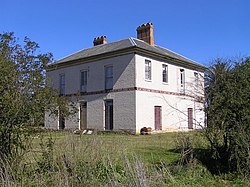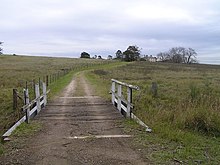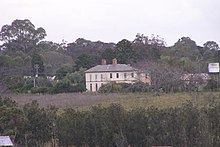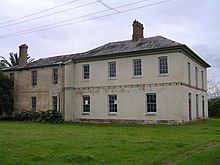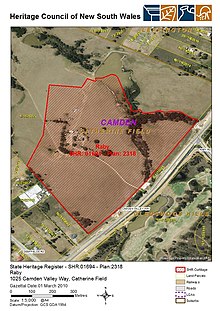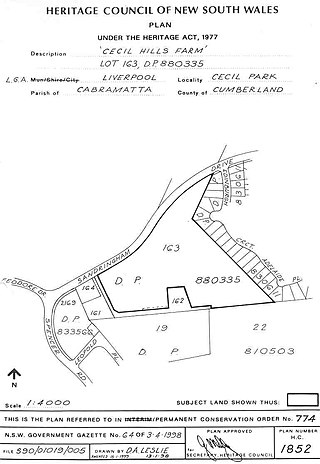The Cowpastures
When the first fleet arrived in Sydney Cove in 1788 they found the soil unsuitable for farming and soon looked towards the heavy clay and loam soils of the Cumberland Plain (to the west) to sustain the colony. Early agricultural settlements were located on the rich alluvial soils of the Nepean, Hawkesbury and Georges River areas, as well as South Creek near St Marys and at the head of the Parramatta River where the settlement of Rose Hill (later Parramatta) was established about six months after the fleet landed. A settlement at the Hawkesbury was established in 1794. [1]
By 1804 much of the Cumberland Plain had been settled and Governor King began to look for other regions in the colony for favourable arable land. The only suitable land within the Cumberland Plain was the area known as the Cowpastures, located in the southwestern corner. This area was named after the discovery in 1795 of cows from the first fleet which had wandered off into the bush. The Cowpastures had remained unoccupied due to the official decree that reserved the land for the wild cattle (to encourage their increase). [1]
In December 1803 Governor King and Mrs King visited the Cowpastures for themselves and the Sydney Gazette reported that Mrs King was the first "white lady" to have crossed the Nepean River. The track to the Cowpastures led from Prospect and on 17 September 1805 James Meehan, under instructions from Governor King, commenced a survey of the track from Prospect to the Nepean Crossing and a rough road followed the marked line. This became known as Cowpasture Road, later the Hume Highway, most of which is today part of the Camden Valley Way. [1]
Several visits to the area by the colonial gentry took place at this time, which resulted in their desire to acquire some of this rich land for themselves. They saw the area as containing very good grazing land. Captain Henry Waterhouse described the area in a letter to John Macarthur in 1804 as follows: " I am at a loss to describe the face of the country other than as a beautiful park, totally divested of underwood, interspersed with plains, with rich luxuriant grass". [1]
Earlier Europeans had described "large ponds covered with ducks and the black swan, the margins of which were fringed with shrubs of the most delightful tints". The Europeans thought the flats were perfect for cattle and the hills would carry sheep. They admired the absence of underbush - probably achieved through Aboriginal burning off - and felt comfortable with a landscape that reminded them of an English gentleman's park. [1]
John Macarthur received the first land grant in the Cowpastures region in 1805 for his role in the early wool industry in the colony. Lord Camden rewarded him with 4,047 hectares (10,000 acres) and Macarthur chose the highly coveted Cowpastures for his grant, though Governor King tried to prevent him from taking it. Macarthur also organised an 809-hectare (2,000-acre) grant for his friend Walter Davidson, who allowed Macarthur to use his land freely after Davidson returned to England. In this manner, Macarthur controlled 19 kilometres (12 mi) of riverbank on the site where the wild cattle had first discovered the best pasture near Sydney. Later purchases and exchanges increased the Macarthur land there to over 10,927 hectares (27,000 acres), an endowment that Governor Macquarie greatly resented. [1]
Other early grants were in the Parishes of Minto and in adjoining Evan, Bringelly, Narellan and Cook. These all lay west of Parramatta. [2] [1]
Governor Macquarie drew up plans in 1820 for the establishment of a town in the area, to be named Campbelltown after his wife Elizabeth's maiden name. With their forced return to England in 1822 these plans never came to fruition and it was not until the arrival of Governor Darling in 1827 that plans were again reinstated and the first settlers were allowed to take possession of their townland in 1831. In the early 1850s the railway line from Sydney to Goulburn was completed, with a station opening at Campbelltown in 1858. When Leppington House was offered for lease in 1865, one of its selling points was that it was near a railway. Campbelltown now provided easy access to Sydney and its markets and grew as the centre of the district. Although Camden was established in 1836, with no railway line it remained a small town. [1]
The large estates that flanked Cowpasture Road (later Camden Valley Way) and the Northern Road were run largely as sheep and cattle farms, with wheat and other grain crops being grown as well until the 1850s. The houses were often built on surrounding ridges or hills, providing sweeping views of the countryside and ensuring that any passing traveller could appreciate the owner's status by viewing their impressive country mansions from the road. This land use pattern of large farm estates and small towns, established in the nineteenth century, remained largely the pattern of development of the area up until the late 1990s. Aerial photographs of the area in 1947 show a rural landscape with some limited urban development on either side of (then) Camden Valley Way. [3] [1]
Raby
Raby, consisting of 1,214 hectares (3,000 acres) of land, was granted to Alexander Riley in 1816, whose principal place of residence was at Burwood. Riley came to NSW in 1804 and, after serving as storekeeper and magistrate in Tasmania and Secretary to the colony in Sydney, he resigned. In addition to farming (particularly sheep farming), he became a prosperous trader, his Sydney partnership with Richard Jones aided by links with Alexander's brother Edward Riley in Calcutta and W. S. Davidson in Canton. [1]
In 1816 Edward Riley joined Alexander in NSW and the following year Alexander returned to England, where he became an agent for colonial trade. Through his knowledge as a British agent for the colonial wool trade, Riley recognised the importance of the quality of wool and decided to invest in 200 Saxon merinos. His nephew, also named Edward, helped select the stock in Germany and accompanied them to the Colony in the George Osborne in 1825. Although the farm buildings at Raby had been neglected by his brother during the intervening period and there was a period of severe drought, Edward Riley jnr was able to foster the herd. In 1827 and for the following three years Raby's Saxons eclipsed all others at the Australian Agricultural Society's Annual Shows. [1]
In December 1817 Raby was leased to George Cribb of Sydney, butcher. There are two renditions of Raby from the 1820s – Joseph Lycett produced an idealised view of Raby for his "Views in Australia" (1824) and a pencil drawing by W. Mason. Both views show a house on the property - a single storey farmhouse set in a cleared paddock surrounded by eucalypt forest. It is thought that this was built in c. 1820. Lycett's romanticised view of Raby mentions the farm upon the Cowpasture Road leading to the Nepean, at the distance of 51 kilometres (32 mi) from Sydney. Helen Proudfoot quotes the following description: [4] [1]
"The three thousand acre property forms a striking contrast between forests and the vast openings of land which have been cleared to accommodate livestock. The Estate on its southern boundary is dominated by a piece of water that, in a connecting chain of small ponds, forms the head of the South Creek, one of the principal and most important branches of the Hawkesbury River. The Pasture at Raby is most fertile and principally devoted to the grazing of fine-woolled sheep: from fifteen hundred to two thousand of which are herded every night on a fresh site. On a hill where the Superintendent's House is seen, flocks containing about 350 sheep each, formed around the bark-hut and fire of a Watchman, who protects livestock from native dogs".
— Helen Proudfoot
According to Murphy [5] the house was one of the best and most substantial of the early houses in the district. It is thought to have been located in approximately the same position as the present house. [6] [1]
One hundred sheep were brought out from Germany by Alexander's son William Riley and by 1830 the family venture had proved successful. A further 4000 hectares was granted to them by the Colonial Secretary and they applied for land near Yass, naming the property Cavan. William Riley was an astute stud breeder and wrote a paper with W. H. Dutton. In 1834 Baron Von Hugel, while overlooking the success of the sheep-farming, referred to Raby in his New Holland Journal as "The large property of a young man named W. E. Riley Esq., whose father introduced Tibetan goats here which, as I hear, thrive well but have not been profitable [7] That same year, Dr Lhotsky referred to Raby as one of the most famous farms in the colony. [8] [1]
By 1830, William Edward Riley, Alexander Riley's son, had taken over the management of the property. [9] In 1833 Alexander Riley died, leaving his property to his son. W. E. Riley married Honoria Rose Brooks, a daughter of Richard Brooks of Denham Court. The couple had two children. The family lived principally at Raby, but was also at times based at Cavan, the Riley property at Yass. [10] Notes in the Riley papers refer to the painting of a paling entrance at the White gate, and to spikes for the bridge rails at the white gate. [11] The location of the gate and the bridge is not specified. [6] [1]
In 1836 William Riley was killed in a riding accident and it appears that his father Alexander Riley largely withdrew from his Australian interests, as indicated by the selling his sheep. However, the Riley family retained ownership of Raby until 1866. The farm was leased to a number of people over this time. [1] Edward Moore and his descendants were the next owners of Raby. A. R. Riley had mortgaged the property, and in 1866 it was sold on behalf of the mortgagors. It was bought by William Moore, grazier, of Booligal on the Lachlan River. [12] It is possible that the Moore family was in occupation of the property before the purchase. [6] [1] Edward Moore was a weaver from Manchester, indicted as a convict for possessing one forged bank note. His wife Elizabeth (who he had married at St. George's church, Southwark, London, in 1814) was convicted at the Lancaster Assizes of possessing three forged bank notes. On 21 March 1818, she and husband were sentenced "to be transported to some parts beyond the seas for the term of 14 years". [1] Moore arrived in NSW in 1818, leaving behind his wife and their two children. Elizabeth arrived as a convict on the Lord Wellington in January 1820, with the children. She was listed as a cook, aged 31, though she was really 37. She and 5 year old Joseph and Ellen, nearly 3 were in rude good health. [1]
In March 1820 Moore petitioned Governor Macquarie for a ticket-of-leave, given for good behaviour and to encourage convicts to earn their own living by working for an employer. His employer, Robert Lowe, said he worked soberly, honestly and diligently. By the 1828 census, he had added Robert, Edward Lomas, James and William to the family. He also cleared 8 hectares (20 acres) of land at Macquarie Fields, 6 hectares (14 acres) of them under crop. In 1830 a second daughter, Elizabeth was born and Edward bought a farm, Drummondville, about 11 kilometres (7 mi) out of Liverpool, growing hay for the teamsters coming to and from Sydney. [1] By about 1835, when he leased Raby from the Riley estate near Campbelltown (now Catherine Fields), Moore was doing very well. The Moore family entertained Governor FitzRoy on his hunting expeditions at Raby. The FitzRoys gave the Moore family a French ormolu mantle clock in the shape of a lyre, in black and gold. It is today at Ellensville, Mount Hunter. [13] [1]
Margaret Browne (née Riley) grew up at Denham Court, Ingleburn, which had a prominent colonial garden. Browne was the first woman to write a book on gardening in Australia, under the name Mrs Rolf Boldrewood. She wrote letters to the much older Ellen Foreman (née Moore), who lived with her parents at Raby, Catherine Field and later established Ellensville, Mount Hunter. These letters survive and have been published as a book by Pacita Alexander, showing the ties between the colonial properties of the Cumberland Plain and hints of the influence of those places on the shared joys of gardening. [14] [1]
A plan of Raby drawn up in 1866 shows that the property consisted of 1,331 hectares (3,289 acres). A note on the plan mentions that "The fences on this property are evidently very old indeed some portions especially on the north-western boundary have been renewed but the stumps of the old posts are visible". A structure may be shown in the location of the house. A gate is indicated in roughly the same location as the present entrance. [1] William Moore carried out improvements on the property, including clearing and fencing. It seems that he managed Raby as a mixed farm. [15] [1]
The present house dates from c. 1875, with the original house being retained for a time for use as a kitchen. An alternate view places the construction of the present house in the 1860s. [6] [1] William Hardy Wilson illustrated the barn and wrote about the "ancient house of Raby, which stood beside the barn has been replaced by one ornamented with florid ironwork in the style of the 1880s". [16] [1] Photographs from the 1880s and 1890s show an alteration to the spacing of the ground floor verandah iron posts around the front door (to not match the alignment of posts above), two frames for climbing roses flanking the front verandah, and extensive garden beds with roses in them. [17] [1]
After the death of William Moore in 1905, the estate was subdivided and offered for sale (with part of it being retained by A. B. Moore). A. B. Moore retained ownership of the estate until 1935 when the property was transferred to Florence Mitchell. The Mitchell family restocked the property with Merino sheep and Hereford cattle. In 1957 Lot 1 was resubdivided; Lot F contained the main homestead farm, and comprised 75 hectares (186 acres). The Mitchell family retained ownership of Raby until 2003, however, the property was not occupied during the 1990s. [6] [1]
The extant Raby estate although much reduced from its original landholding, remains a notable pastoral landscape, with the homestead overlooking the creek, enclosed by surrounding hills and dales on part of the original 1816 land grant. [1]
